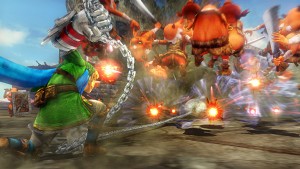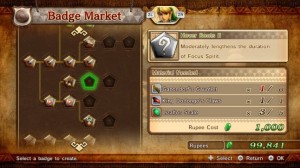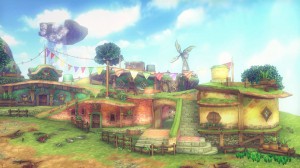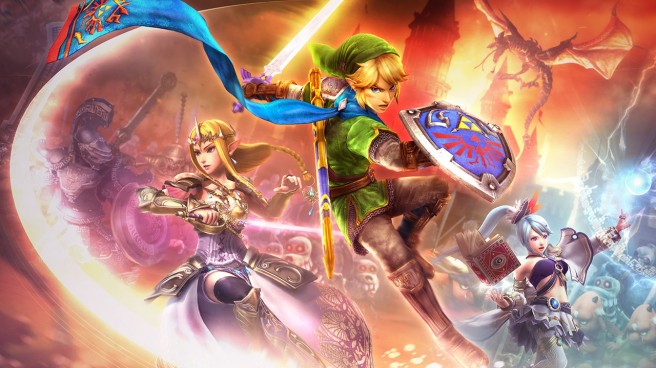[Review] Hyrule Warriors (Wii U)
System: Wii U
Release Date: September 26, 2014
Developer: Koei Tecmo
Publisher: Nintendo
Author: Vincent
Calling me a Legend of Zelda fan would be a bit of an understatement. If you were to step into my room, you’d be blinded by the posters and merchandise scattered from one wall to another, all finished off with my saddening number of physical Zelda titles. So with the announcement of Hyrule Warriors during last December’s Nintendo Direct, I was nothing short of excited; providing an excuse for having our beloved Zelda worlds and characters collide in one epic horde fighting action game sounds like a dream come true, and every day I spent waiting for the game felt like an eternity. Now that I’ve sped my way through this long journey over the past week, I can safely say my excitement was placed in good hands.
With tons of options and modes to play, there’s only one thing that you’ll continue to do throughout every adventure – and that’s slaying familiar Zelda enemies with flashy-looking attacks. Scrapping the typical Zelda puzzle-solving battles for the huge Dynasty Warriors horde battles, you’d think seeing Link and Zelda destroy masses of enemies would look off. However, Hyrule Warriors seamlessly places characters we’re used to seeing in their typical environments into war-ridden worlds by beautifully mending all of the art-styles from the past Zelda games while preserving classic music and enemies. Playing as the different characters also feels surprisingly diverse. Each one offers new weapons and ways to play that give you a powerful feeling when unleashing the colorful albeit simple combos. Watching Zelda use her light arrows to plow through a group of 100 baddies is nothing short of satisfying thanks to the vibrant and flashy effects. That same sense of satisfaction carries throughout the course of the game, lingering with you as you play with newcomer Lana all the way to the ultimate villain Ganondorf.

The main part of the game where you’ll be overcoming foes in is Legend Mode, which which tells a central story while explaining how our favorite Zelda characters came together to save the land of Hyrule. While it does introduce some interesting characters and take a few surprising twists, it mainly falls flat. Only a few characters receive development, and new ones are simply thrown into the mix without any explanation as to who they are or how they got there. During one of the beginning missions, however, we learn that the main villain uses her dark powers to create portals, allowing the series’ overly familiar worlds and characters to come pouring through them and help fend off evil. This is what allows you to play as characters like Midna and in worlds like Lake Hylia. For any Zelda fan, it’s a sight to behold. Also, for those wondering, Hyrule Warriors does stay true to its roots; the Zelda mythos isn’t drastically changed to fit into the story (not to mention the insane amount of Zelda references littered throughout).
If you don’t feel like you character is strong enough to take on the challenge at hand, you can wander over to the notably deep Bazaar. Here you can combine weapon stats, level up your characters using rupees gained in battle, or use dropped materials to boost your characters stats and create helpful potions. All of these actions make it seem like they actually have an effect on the outcome of battle, as almost all of them aid exponentially in making your character feel just that little bit stronger. In battle, it could do as little as preventing a little bit of fire damage or go as far as giving your character new flashy combos that look as colorful as they are deadly.

Hyrule Warriors’ gameplay is only bettered when you take into account the visual scale and the fantastic music that comprises the experience. Skyloft, for instance, not only looks better than what was presented in Skyward Sword, but also possess a fantastic remix of the original theme. The level design goes a long way, with action constantly taking place on every side of the map. Making important choices is also a big part of the experience, such as having to decide between saving Impa (who’s on the whole other side of the map) or taking over the keep that’ll let you secure that area and put a halt to the constant spawning of enemies. These actions don’t just affect what happens in the oncoming moments, either, as they could affect the whole tide of the battle, causing the enemies to take over your precious keeps and cause their minions to invade. This means you need to not only destroy thousands of enemies with your strength, but also plan out which keeps you’ll want to take and which bosses to defeat with your intelligence. These two ideas blend perfectly in creating a fun and memorable experience that is only tainted by a few small issues.

Throughout these battles, bosses will occasionally appear. Being much larger and stronger than your typical monster for the most part, these giant Zelda-inspired beasts will run through your keeps and take them for the opposing side if you aren’t fast enough. Unfortunately, this idea sounds much better on paper than it is actually executed. There are only a small handful of them and each one follows the much flawed ‘attack…wait…attack…wait’ system where you wait to exploit the bosses weakness in the same fashion like many Zelda games before it. In a fast-paced game such as Hyrule Warriors, these slow bosses feel out of place and halt the action. For example, the Skyward Sword boss “The Imprisoned” has you hacking away at his toes to knock him over, but as you approach him, he moves in a painfully sluggish manner and repeats the same attack. The attack also lasts a good 30 seconds, so you’ll find yourself running around in circles until he allows himself to be hit once more.
Another flawed idea in Hyrule Warriors is the multiplayer, which actually piqued my interest me before release. Unlike many other multiplayer games where both of the player’s screens are presented on the television split by a border, this game takes a different approach. One player’s action is on the GamePad while the other is on the television. This sounds good on paper, but when actually being used, the TV’s resolution looks as if someone took the GamePad and stretched it out, resulting in an ugly-looking game. Also, the frame-rate takes a huge hit. Coming from someone who doesn’t typically notice frame-rate differences, the drop is devastating and only gets worse when two characters begin fighting foes close by. If you can get beyond these technical flaws, though, local co-op still provides lots of fun.
Once you’ve leveled up your characters, finished the story, and played to your heart’s content with friends, you can hop on over to the Adventure Mode. The original overworld map from the original Legend of Zelda is used here and is split into a whopping 148 space board where you complete certain tasks that reward you with new weapons, materials, and even new warriors. You even use classic Zelda items and hidden secrets present in the original game to advance your progress. Adventure Mode, somewhat surprisingly, kept me invested longer than the story – and I’ve still yet to complete it.
Even after that, there’s still another mode to dive into called “Challenge Mode”. This mode has you killing a set amount of enemies in the given time, and will be updated on a weekly basis. The challenges are fun, but not truly different enough to really warrant players coming back over many weeks.

Hyrule Warriors is a game that took me by surprise. Its addictive gameplay, combined with an exceptional soundtrack, visual feats, and fantastic fan service are something surely worthy of praise. All of these elements make the experience that much more enjoyable for any Legend of Zelda fan. Call me biased – or call me a fanboy – but there’s no denying that Koei Tecmo has created something worthy as a great addition to both the Zelda and Dynasty Warriors franchises.

I’d be lying if I said I didn’t have a few nitpicks with Hyrule Warriors after spending over fifty hours with the game. However, besides those little aforementioned issues, the experience was simply a blast. Pulling off combos and watching my favorite characters slay the series’ biggest enemies made it hard for me to put down the controller, especially after the credits began to roll. Even without the Zelda elements to keep me going, it’s obvious this game has enough action and flare to make even the non-Zelda and Dynasty Warriors fans keep coming back for more.
